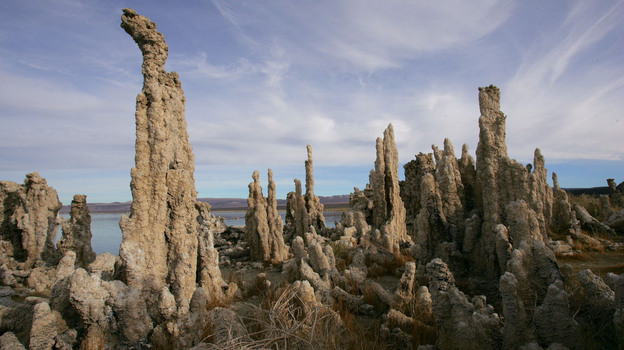 Ben Margot/AP
Ben Margot/AP Researchers claimed in late 2010 that they found bacteria in Mono Lake, Calif., that survived on the poison arsenic in the place of an element thought essential to life. The report was immediately greeted with skepticism from the scientific community.
2011 may go down as the year of the retraction in the scientific world.
Among the highly publicized discoveries that got debunked this year: a genetic basis for longevity; a new form of life; an explanation for autism; and a link between a virus and chronic fatigue syndrome.
All of these non-discoveries have something in common: They involved findings that both scientists and the public badly wanted to believe.
One thing most people would like to believe is that science can help us live to be 100. So it was no surprise that people got pretty excited about a 2010 study in the journal Science that offered a genetic explanation for long life.
The study identified 150 clusters of genes that seemed to be common in centenarians.
"The genetic control was very strong and allowed some prediction of who would live a long time," says David Goldstein, a professor of genetics at Duke University.
But as appealing as that idea was, Goldstein says he had major doubts.
"Everybody that does a lot of genome-wide association studies not only knew that there was an issue, but worked out what the issue was more or less immediately," he says.
The issue had to do with the specific devices, known as gene microarrays, used to identify and sequence the genomes of these centenarians, Goldstein says. For certain gene variants, he says, the devices are known to produce misleading results.
"At least some of the conclusions in the paper were due to this source of artifact," he says, which led the authors to retract their paper.
An Arsenic-Based Life-Form?
Another study based on an appealing idea described a bacterium that appeared to defy the rules of nature. This bug, from a lake in California, seemed to use the poison arsenic in place of an element thought essential for life.
NASA held a big press conference late last year to announce the finding, which provoked a lot of talk about the possibility of extraterrestrial life. But many experts in the field were unimpressed by NASA's event.
"It took five minutes to decide it really shouldn't have happened," says Simon Silver of the University of Illinois, Chicago, who is an expert on organisms that can tolerate high levels of arsenic.
Critics said the study's data failed to back up its conclusion that this organism was incorporating arsenic into its DNA. Eventually, the journal Science published some of these criticisms online.
Then, just a few weeks ago, Silver's lab published a sequence of the organism's genome. The genome showed nothing that would suggest the organism is using arsenic in a unique way.
"It's not a bizarre bug at all," Silver says. "It has the normal range of genes, and there's just nothing surprising in its genome at all."
Even so, the authors stand by their study. And so far, the journal Science hasn't retracted it.
Autism And Vaccines
Parents of children with autism have long hoped for a better explanation of the disorder. So many of them embraced a 2005 article by Robert F. Kennedy Jr. that suggested a government cover-up of a link between autism and the vaccine preservative thimerosal. The piece was published in the online magazine Salon and in Rolling Stone.
Scientists soon pointed out major errors in the piece, and Salon published a number of corrections.
Then this year, the writer Seth Mnookin published a book called The Panic Virus, which included a thorough dissection of the Kennedy piece.
"When my book came out, Salon used that as an occasion to sort of revisit the entire controversy and said publicly that it had been a mistake to publish it, and retracted the piece, and actually pulled it off of their website," Mnookin says.
Rolling Stone, though, hasn't followed suit.
Chronic Fatigue Syndrome
One of the most prominent retractions this year involved chronic fatigue syndrome, a mysterious problem that patients and scientists have been trying to understand for many years.
The mystery seemed like it might be solved in 2009 when a study in the journal Science linked chronic fatigue to a mouse retrovirus called XMRV. That study was a big deal for people with chronic fatigue.
"This is a group of people that initially were basically told by a lot of doctors: 'You're not sick, get over it,' " says Ivan Oransky, co-founder of a blog called Retraction Watch, and the executive editor of Reuter's Health.
At first, the study seemed to confirm that chronic fatigue was caused by a virus. But Oransky says the results haven't held up.
"Now it's become clear that that was a house of cards," he says. "There was something wrong with those results, and therefore there was something wrong with the conclusions."
Oransky says this particular house of cards seems to have been built using contaminated samples, poorly designed experiments, and scientists who desperately wanted to believe their own results.
Source: http://www.npr.org/2011/12/29/144431640/debunked-science-studies-take-heat-in-2011?ft=1&f=1007
andrew luck day light savings time 2011 hocus pocus hocus pocus bj penn roasted pumpkin seeds roasted pumpkin seeds
No comments:
Post a Comment
Note: Only a member of this blog may post a comment.